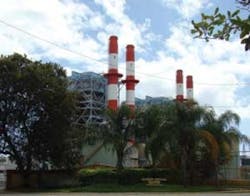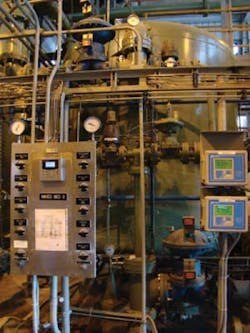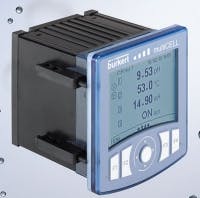Sometimes the Shell is All You Need
• Puerto Rico Electric Power Authority's Aguirre thermoelectric plant enjoys multiple benefits with a DI wastewater treatment upgrade, reducing cost and service expenses.
Operations and chemistry management for the Puerto Rico Electric Power Authority (PREPA) Aguirre thermoelectric plant in Salinas, Puerto Rico, report dramatic reduction of acid, caustic and man-hours for co-flow deionization/demineralization (DI) of boiler feedwater, as well as man-hours for DI wastewater treatment, by changing its ion exchange (IX) resin and regeneration procedure. The move also resulted in performance recognition for the plant and its chemist, including the Manuel A. Perez Government Employees Performance Prize.
The resin change was necessitated by spiraling costs for acid and caustic due to increasing hardness in its deep well boiler feedwater source. During the past 30 years, the water table has dropped 20 ft., with magnesium and calcium now reaching 420-450 parts per million (ppm) ; chloride 80-90 ppm; and silica 37 ppm. No new capital investment was available to address the problem. The resin replacement solution, seen as especially valuable for co-flow DI plants, was significantly aided by high-predictability cost comparison software.
"Solving the problem by changing the water source was not an option when the condition was detected," said Justo Gonzalez, operations manager. "PREPA owns a lake, but there was no capital available at that time for the channel, pipeline, pumps, and probably also ultrafiltration pretreatment that would have been required."
"Changing the ion exchange resin is now being recommended as the best way to improve performance of the demineralization system at other PREPA plants that have the same problem with their deep well sources."
To protect turbine blades and minimize deposit buildup in steam piping, the plant requires boiler feed water silica (SiO2) at < 125 parts per billion (ppb), as well as targeting complete removal of chloride (Cl-1), magnesium (Mg), and calcium (Ca). Since the installation of the new resin, SiO2 is running < 50-60 ppb, and Cl-1, Mg, and Ca are non-detectable.
Results from New Resin
"For regeneration before we changed resins, we needed 11 lbs of acid per cubic foot (cu. ft. or ft³) of resin, and now we only need 5.5-6 lbs.," said Luis A. "Tony" Reyes Santini, the plant chemist. "Meanwhile, 10 lbs. of caustic in the bath previously is now down to about 6-7 lbs."
"As a result, we have not only saved more than $750,000 in the first year and over $1,000,000 in the second year in chemical costs, but also due to longer service cycle time we now need 40% less man-hours for demineralization and 20% less for DI wastewater treatment. That has allowed me to use my technicians for other analyses to help make the plant run more efficiently, while I have more time for equipment repair and maintenance."
"I have also cut water consumption for regeneration by 25%, or about 100,000 gpd, helping us to avoid a crisis in water supply for the high pressure boilers."
An IX co-flow DI system serves each of the plant's two 450 MW boilers. Each 1,005°F, 2,600 psi boiler uses 1,950 gpm of feedwater, and requires 6000 gph of makeup water. The DI systems perform eight-to-10 12,000-gal. regenerations per month, generating about 6 million gal. of wastewater that derives from DI and some polishing inside the system.
Each of three treatment trains contains three 500 ft³ cations and three 250 ft³ anions. Raw water conductivity has reached over 900 µmhos/cm. Cation conductivity is 1,400 µmhos/cm and the anion ranges from 15-40 µmhos/cm. Conductivity of water out of the final step mixed-bed is 0.056 µmhos.
Santini recalled that when shipments of acid and caustic to the plant had reached 16 truckloads per month, he was asked to investigate if it needed to be that much.
"I started consulting with our distributor, Manuel Bismarck, who had experience as a plant chemist," he said. "After he had been visited by Fabio Sousa from Purolite resins, he advised that a resin change might help. I then looked at a variety of different resins, and found them all to be the same, except for Purolite, which had a shallow shell technology."
"We took about six months to test their resin on the cation in one of the vessels, and proved we could gain 37-38% savings on chemical costs. We provided a comprehensive presentation for plant management, and then took a year and a half to changeover to Purolite, which also helped us change regen times and flows. We've found that the higher price for their resin has been more than made up for by the savings we have realized, and we have much appreciated their high level of technical support."
Shallow Shell Technology
The combination of Purolite's SST60H and PFA300 resins that was installed here is recommended by the vendor as an innovative approach for coping with jumps in prices for acid and caustic, and is seen as especially valuable for co-flow DI plants.
Purolite describes its SST™ family of high-efficiency ion exchange resins as based on "shallow shell technology." The resins have inert centers. Only the outer shell is functional¬ized, which shortens the ion exchange diffusion path. This is said to lead to more complete ion exchange and regeneration, which provides for higher capacities, lower leakages, better handling of iron and organic fouling, and more resistance to oxidation than standard grade resins.
More complete regeneration in turn allows for a higher, more efficient utilization of the regenerant. The company estimates that when compared to conventional softening or demineralization resins, regenerant cost reductions of 20-50% are often possi¬ble without sacrificing capacity or increasing leakages.
Francis Boodoo, Purolite USA technical director, noted two factors that were critical to the successful application of the special resin at PREPA's Aguirre plant.
"First, there was more opportunity to improve the efficiency of an already existing co-flow plant like this one, where service water and acid enter the cation, and service water and caustic enter the anion, in the same direction, as contrasted with a counter-flow plant, where service water and regenerants enter in opposite directions," he said. "With co-flow, we can accomplish lower leakage of sodium out of the cation vessel and lower leakage of silica out of the anion vessel, and thereby accomplish reduced regenerant usage, easily 30-40%, and lower leakage at the same time."
"Second," he continued, "we were able to offer an especially high level of technical support for the transition from the standard resin to the special resin. This derived from customized software, based on 15 years of field results that provided for high levels of predictability, that allowed for cost-comparison evaluation in spreadsheet-type format."
The Purolite Company is based in Bala Cynwyd, Pennsylvania, USA. Contact: 800-343-1500, [email protected] or www.purolite.com
More Water & WasteWater International Issue Articles
More Water & WasteWater International Archived Issue Articles




